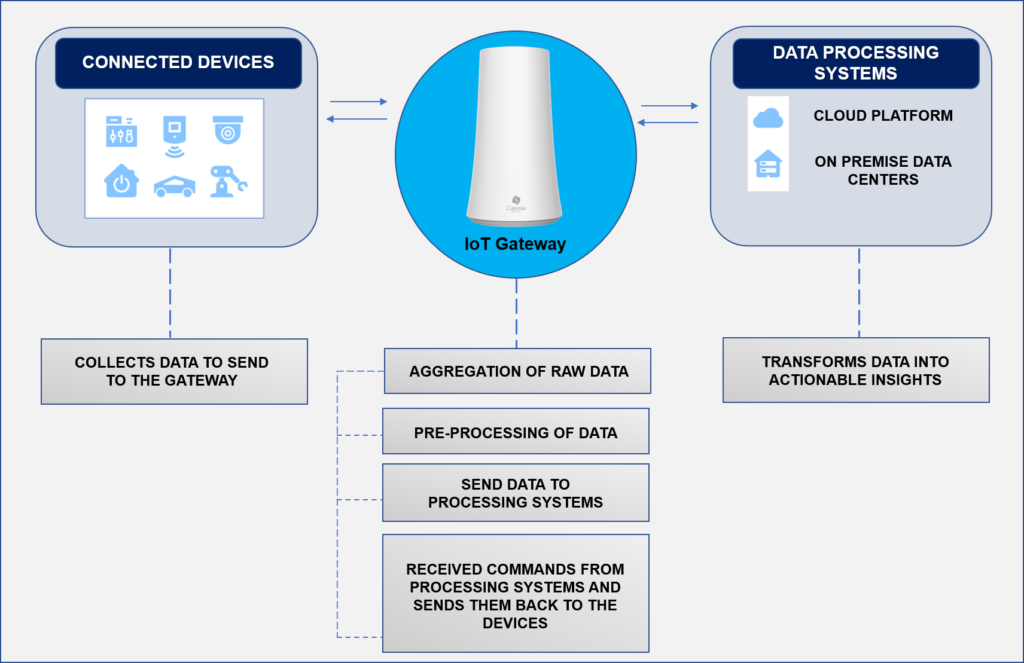As the Internet of Things (IoT) expands, today’s enterprises find themselves faced with the challenge of integrating multiple wireless devices and protocols, many with different power and connectivity requirements. There are several challenges that today’s enterprises are faced with to effectively deploy a successful IoT application. Among these are cost, interoperability, and security to name a few. This blog post will discuss the importance of an IoT gateway in IIoT, the challenges today’s enterprises are facing and tips to overcome these challenges.
What is an IoT Gateway?
For starters, let’s provide a brief description of an IoT gateway. In simplest terms, an IoT gateway is a hardware device that houses application software to perform essential tasks. It bridges the communication gap between devices, sensors, equipment, and the cloud. By connecting the cloud, an IoT gateway offers local processing and storage, as well as the ability to autonomously control field devices based on data inputs by wireless sensors. An IoT gateway also enables customers to securely process and filter data for analysis. In addition, an IoT gateway also helps to ensure that the data generated by devices and systems are securely sent from the edge to the cloud.

Why is an IoT gateway important for an IoT Solution
The importance of an IoT Gateway device is normally determined by the number of essential tasks/actions that an end-user is trying to perform by this device. Below are a few of the common tasks:
a. Facilitate compatibility across an IoT network. Essentially, an IoT Gateway ensures this by supporting several communication protocols like Bluetooth, Wi-Fi, ZigBee, LoRA, etc.
b. All the devices that have relevant sensors installed on them that require monitoring such as temperature, humidity, and/or proximity
c. These sensors are IP-based meaning that an IoT Gateway manages the connectivity of these sensors and sends relevant data to the cloud.
In sum, an IoT Gateway is required to make devices available online through sensors and the cloud. Additionally, to bring the IoT network to life an IoT gateway also performs many operational tasks such as managing device configuration, performing device authentication for secure network access and supporting edge analytics.
What are some of the common IoT deployment challenges?
There are many challenges involved in deploying an IoT solution. Let’s review some of these in further detail.
a. Selecting the right connectivity for your enterprise needs
There are many different types of connectivity options available. The most common are wired versus wireless connectivity. While many deployments default to Wi-Fi for connectivity, some use cases may have specific needs or require connectivity in areas where Wi-Fi isn’t always available. In such cases, cellular connectivity may be a preferred option because it offers low power consumption and long battery life for devices, and therefore greater accessibility. Bluetooth technology is also a popular choice for many companies because of its low cost, low power consumption and long battery life. Also, since Bluetooth is a standardized wireless technology, a high level of compatibility among devices is guaranteed, regardless of model or brand.
b. Is integration with an existing system possible?
Information technology (IT) and operational technology (OT) have traditionally operated as independent systems. However, with the growth of IoT deployments comes the need for seamless integration. Typically, IoT system integration is managed through APIs to third parties, allowing for automation and control provisioning. As a result, finding a solution provider that can provide easy integration with existing systems is essential.
c. Security
With a steady increase in cybersecurity threats across all industries, today’s enterprises must safeguard their data and those of their customers at all times. Most traditional cybersecurity protection tools have focused on networks and the cloud. However, over-the-air (OTA) vulnerabilities are frequently overlooked. Wireless technologies such as Wi-Fi, WLAN and Bluetooth are used in many applications, but little has been done to address the OTA vulnerabilities. The complexity of these wireless protocols could lead hackers to access or take control of a device. Therefore, IT teams should carefully address the potential of OTA vulnerabilities and safeguard IoT devices. This can be accomplished through regular testing, ensuring strict levels of encryption, updating hardware and software versions, and keeping an updated database of known threats/attacks to monitor device response and detect anomalies.
In summary, this blog post covered the basics of an IoT, the IoT deployment challenges and some proposed solutions to overcome these challenges. The future of IoT looks bright and promising. With all the future IoT predictions and concepts in the works, if today’s enterprises can overcome the obstacles of connectivity and communication between all devices, they will not only gain a competitive edge but will benefit from greater ROI now and in the future.
Have a unique IoT solution you’re looking to deploy? Cassia Networks offers cutting edge Bluetooth IoT products and solutions that will allow you to successfully deploy your IoT project with easy, flexibility while remaining cost effective.
Interested in a free demo of Cassia’s Bluetooth IoT products and solutions. Contact sales@cassianetworks.com.








